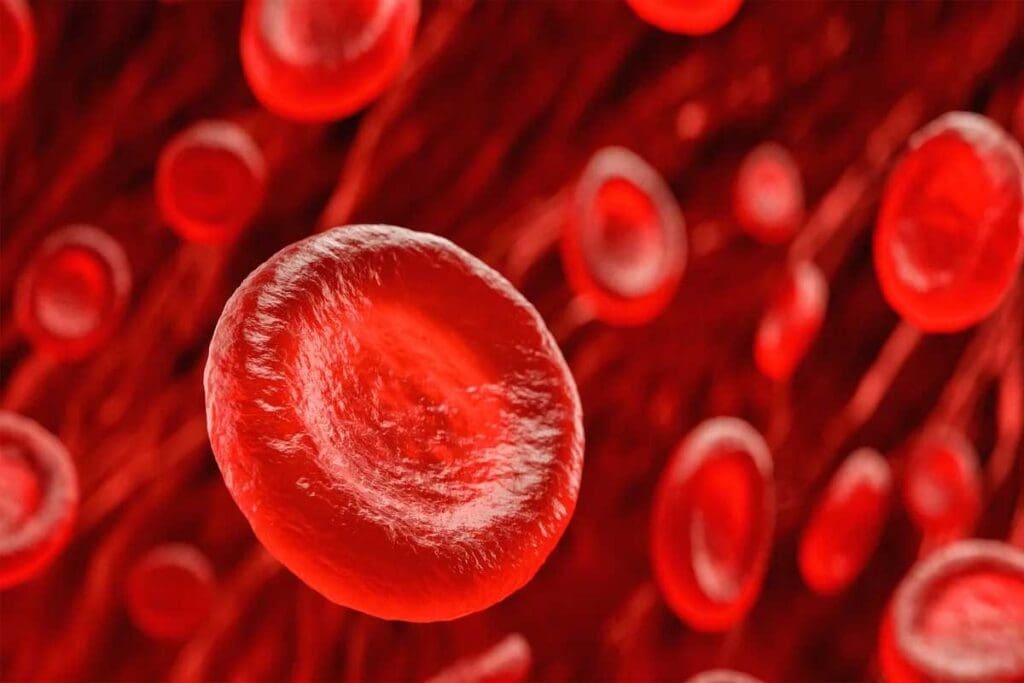Last Updated on November 20, 2025 by Ugurkan Demir

Sickle cell anemia is often linked to people of African descent. But, it can also affect Caucasians and others.Find out how do white people have sickle cell anemia is among white people and how genetic traits influence it.
Liv Hospital believes that sickle cell anemia isn’t limited to any ethnic group. It’s more common in Africans and African Americans. But, people from Hispanic, Middle Eastern, Asian, Indian, and Mediterranean backgrounds can also get it.
It’s important to understand the genetics of sickle cell anemia to help everyone. This disease can happen to anyone, no matter their ethnicity.

To understand sickle cell anemia, we must first know what it is. It’s a genetic disorder that changes the hemoglobin in red blood cells. This makes them sickle-shaped under certain conditions.
Sickle cell anemia is an inherited blood disorder. It’s caused by abnormal hemoglobin, called hemoglobin S. This makes red blood cells rigid and sickle-shaped, mostly when oxygen levels are low.
The disease comes from mutations in the HBB gene. This gene tells our bodies how to make a part of hemoglobin. People with sickle cell anemia have two bad HBB genes, one from each parent.
Sickle-shaped red blood cells cause many health problems. These include:
These issues happen because sickled red blood cells can’t move well through small blood vessels. This leads to vaso-occlusion and tissue damage.
Sickle cell anemia is inherited in an autosomal recessive pattern. This means you need two bad HBB genes (one from each parent) to have the disease.
People with one normal and one abnormal HBB gene are carriers. They don’t show all the disease symptoms but can pass the mutated gene to their kids.
The genetic cause of sickle cell anemia shows why genetic counseling is key for families with a history of the disease.

Sickle cell anemia is a genetic disorder found worldwide. Its prevalence varies by ethnicity and geography. In the United States, it affects over 100,000 people, and globally, it impacts about 20 million.
In the U.S., most with SCD are Black or of African descent. Yet, it’s not limited to these groups. It’s also common in Mediterranean, Middle Eastern, and South Asian communities.
SCD’s spread is tied to malaria’s history. The sickle cell trait protects against malaria. This has made it more common in malaria-prone areas.
In Africa, sub-Saharan regions have the highest SCD rates due to malaria. The Middle East, India, and the Mediterranean also show significant prevalence.
The sickle cell trait has been around for thousands of years, starting in Africa. Migration has spread it worldwide.
The transatlantic slave trade introduced the trait to the Americas. It became common in certain populations there.
The trait offers protection against malaria, giving a survival edge in malaria areas. Carriers are less likely to die from malaria.
But, having two copies of the mutated gene causes SCD, a serious condition. This shows the trait’s double-edged nature.
In summary, sickle cell anemia’s prevalence is shaped by genetics, history, and environment. Understanding these factors is key to tackling SCD’s global health challenges.
Sickle cell disease is more common in some groups, but it can affect anyone. White people can also have it, even if it’s less common. Knowing this helps us understand the disease better.
Recent studies have shown that sickle cell anemia is not as rare in white people as we thought. These studies look at who gets sickle cell disease and where it’s found.
Epidemiological studies show that sickle cell disease can happen to people of many ethnicities, including Europeans. This means we need to know more about it, not just in certain groups.
About 1.8% of sickle cell patients in US hospitals are white. This shows that the disease is found in white people too. It’s important for doctors to think about sickle cell in patients of all backgrounds.
This fact is key for doctors. It tells them to watch for sickle cell disease in all patients, not just certain ones. It also helps us understand the disease better.
Newborn screening shows that about 3 out of every 1,000 white newborns have the sickle cell trait. This is lower than in some groups, but it’s important to know about it.
The sickle cell trait in white newborns means the disease’s genes are more common than we thought. This is important for genetic counseling and families with a history of the disease.
In summary, sickle cell anemia is not just for certain groups; it can affect white people too. Knowing this helps doctors and the public understand and treat the disease better.
Sickle cell anemia can affect anyone, not just those of African descent. It’s more common in certain groups, like those from the Mediterranean, Middle East, and South Asia. Understanding this helps us see how complex this genetic disorder is.
People from the Mediterranean are at a higher risk for sickle cell. Countries like Greece, Turkey, and Italy have more cases. This is because of historical genetic exchanges and past malaria presence.
| Country | Sickle Cell Trait Prevalence |
| Greece | 1 in 200 |
| Turkey | 1 in 300 |
| Italy | 1 in 250 |
Middle Eastern people also have a higher risk of the sickle cell trait. This is due to past malaria, which changed their genetics over time.
South Asians, like those from India and Pakistan, also have a high rate of the sickle cell trait. Their genetic makeup is complex, influenced by genetics and environment.
Key Findings:
To understand how Caucasians can inherit sickle cell anemia, we need to look at the genetics involved. Sickle cell anemia is an autosomal recessive disorder. This means a person needs two defective hemoglobin genes, one from each parent, to have the condition.
The inheritance patterns for sickle cell anemia are the same for all ethnic groups, including Caucasians. If both parents carry the sickle cell trait, there’s a 25% chance their child will get sickle cell anemia. This chance is the same for all parents, no matter their ethnicity.
To inherit sickle cell anemia, a Caucasian must have parents who are carriers. The chance of this happening depends on the sickle cell trait’s frequency in their family and ancestry.
People with mixed ancestry face a higher risk of sickle cell anemia if one parent carries the trait. Mixed ancestry increases this risk because it combines genes from different populations. Some of these populations may have a higher rate of the sickle cell trait.
For example, someone with a Caucasian parent and a parent from a high-risk group (like African or Mediterranean) is at a higher risk., knowing your genetic risk is key for those with mixed ancestry.
Being a carrier means having one normal and one sickle cell gene. Carriers are usually healthy but can pass the sickle cell gene to their kids. The carrier rate among Caucasians is lower than in other groups, but it’s important for genetic counseling.
Many Caucasian carriers don’t know they carry the trait unless they get tested. If two carriers have kids, there’s a chance their child could get sickle cell anemia. So, knowing your carrier status is vital for family planning and managing disease risk.
Sickle cell anemia diagnosis is tough in non-traditional populations. It’s more common in people of African descent but can happen in others, like Caucasians. Because it’s rare in these groups, it’s often missed or delayed.
White patients might not get checked for sickle cell anemia because it’s seen as a black disease. This thinking can make doctors forget to look for it in white patients with symptoms.
Clinical experience and heightened awareness are key to beating this bias. Doctors need to watch out for sickle cell anemia in all patients, not just those of African descent.
The rules for diagnosing sickle cell anemia are the same for everyone. Doctors use symptoms, blood tests, and genetic tests to spot it. These tests help find the exact cause of the condition.
Genetic testing is very important for diagnosing sickle cell anemia, even in non-traditional groups. It finds the exact genetic changes that cause the disease. This helps doctors diagnose and treat it right.
In short, finding sickle cell anemia in non-traditional groups needs careful attention, sticking to the right diagnostic steps, and using full genetic testing. With these steps, doctors can make sure patients get the right diagnosis, no matter their background.
Caucasian patients with sickle cell anemia show symptoms typical of the disease. These include pain episodes, anemia, and a higher risk of infections.
Studies show that sickle cell anemia symptoms are similar in all ethnic groups, including Caucasians. But, how often and how severe these symptoms are can differ.
A study in the Journal of Clinical Hematology found that Caucasian patients might face fewer complications. This is because they often have better access to healthcare.
Case studies have shown how sickle cell anemia affects Caucasian patients. For example, a report in the New England Journal of Medicine talked about a Caucasian man. He had recurring pain and anemia, typical of sickle cell crisis.
“The clinical presentation of sickle cell anemia in this Caucasian patient was indistinguishable from that seen in patients of African descent.”
The severity of sickle cell anemia can differ a lot between ethnic groups. This is due to genetic factors, environment, and healthcare access.
| Ethnic Group | Average Age at Diagnosis | Frequency of Pain Crises |
| Caucasian | 5-7 years | 2-3 per year |
| African American | 3-5 years | 3-4 per year |
| Mediterranean | 4-6 years | 2-3 per year |
It’s important to understand these differences to give the best care to all sickle cell anemia patients, no matter their ethnicity.
Treating sickle cell anemia requires a mix of old and new methods. It’s important to tackle the disease from all angles. This way, we can manage it better.
For sickle cell anemia, treatments include hydroxyurea, blood transfusions, pain management, and bone marrow transplants. Hydroxyurea helps by cutting down on painful episodes. It also means fewer blood transfusions are needed.
| Treatment | Purpose | Benefits |
| Hydroxyurea Therapy | Reduce frequency of painful crises | Decreased need for blood transfusions, reduced pain |
| Blood Transfusions | Increase normal red blood cell count | Reduced risk of stroke, improved oxygen delivery |
| Pain Management | Control acute and chronic pain | Improved quality of life |
| Bone Marrow Transplants | Potential cure by replacing sickle cell-producing bone marrow | Possible cure, elimination of symptoms |
Personalized medicine is key in managing sickle cell anemia. Genetic tests help find the exact cause of the disease. This way, treatments can be made just for each person. It leads to better results and fewer problems.
Genetic counseling is vital for families with sickle cell anemia history, even in Caucasian families. Counselors explain the risks of passing the disease to future generations. They also talk about family planning options. Knowing the genetic risks helps families plan better.
Sickle cell anemia is often seen as a disease mainly found in people of African descent. But, this view ignores the fact that it can affect anyone, no matter their ethnicity.
While it’s less common in white people, it’s a serious issue. It’s important to remember that sickle cell anemia isn’t limited to one race. A patient’s race shouldn’t affect their diagnosis.
Learning about the genetic causes of sickle cell anemia helps us fight misconceptions. Proper diagnosis and awareness are key to managing the disease. This ensures everyone gets the care they need.
Spreading the word about sickle cell anemia in different communities helps clear up misunderstandings. This way, everyone can get the care and support they deserve.
Yes, Caucasians can get sickle cell anemia. It’s more common in African Americans. But, it can affect anyone, no matter their ethnicity.
Yes, white people can get sickle cell anemia. It’s not limited to certain ethnic groups. It happens in anyone with the right genetic mutation.
Yes, a white person can have sickle cell disease. It’s not exclusive to any ethnic group. It can affect anyone with the disease-causing mutation.
Sickle cell anemia is rare in white people. But, it can happen. Studies show about 1.8% of sickle cell disease patients in US hospitals are white.
Yes, Caucasians can inherit sickle cell anemia. It happens if they have the disease-causing mutation. The risk is higher if both parents carry the sickle cell gene.
Symptoms of sickle cell anemia are the same across ethnic groups. But, severity can vary. White patients with the disease may have similar symptoms as others.
Sickle cell anemia is often overlooked in white patients. It’s seen as a disease mainly affecting African Americans. This can lead to delayed diagnosis and treatment in white patients.
Caucasians are diagnosed with sickle cell anemia the same way as others. Genetic testing and blood tests are used. Accurate diagnosis is key.
Yes, white people can be carriers of the sickle cell gene. This is important for those with Mediterranean, Middle Eastern, or South Asian ancestry.
Yes, genetic counseling is necessary for at-risk Caucasian families. It helps them understand their risk and make informed reproductive health decisions.
Subscribe to our e-newsletter to stay informed about the latest innovations in the world of health and exclusive offers!